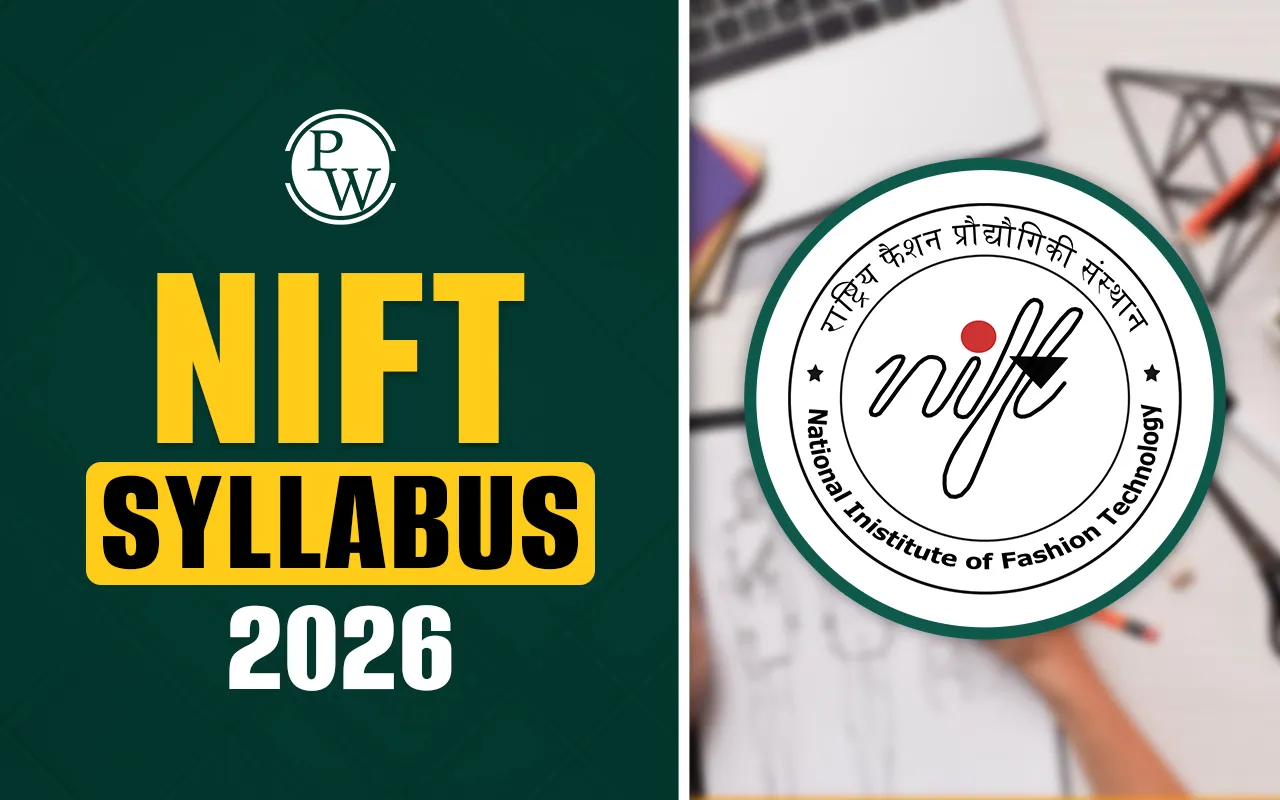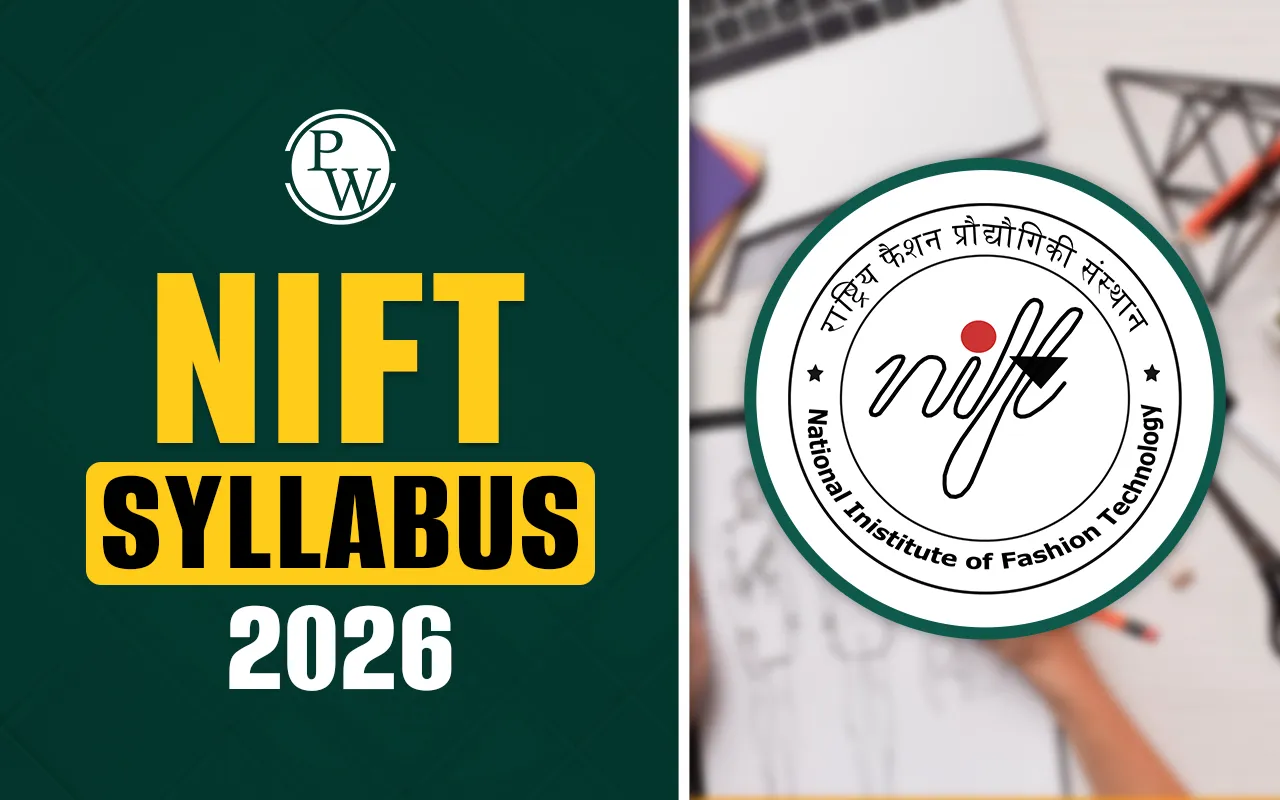
NIFT Syllabus 2026: National Institute of Fashion Technology (NIFT) holds an entrance exam every year. Students take this exam to join design and fashion courses. The exam has written tests, practical tests, and an interview.
Therefore, understanding the NIFT Syllabus 2026 helps candidates see what to study and how to get ready. Here, candidates will find the full NIFT syllabus explained so that they can prepare effectively for their upcoming exams.
NIFT Syllabus 2026 for Creative Ability Test (CAT)
Provided here is the CAT Syllabus that checks one's creativity, drawing skills, observation, and ability to think differently. This part of the NIFT Syllabus 2026 focuses on how well you can express ideas through sketches and visual concepts.
| NIFT Syllabus 2026 for Creative Ability Test (CAT) | |
|
CAT Component |
Detailed Description |
|
Creativity & Originality |
Ability to create fresh ideas, imagination-based drawings, new visual concepts, unique storytelling, non-repetitive sketches, and personal design style. |
|
Design Concept Development |
Understanding shapes, forms, textures, patterns, converting ideas into meaningful visuals, developing themes, creating moods, and giving purpose to sketches. |
|
Observation & Visualization |
Observing real-life objects, capturing details, drawing from memory, imagining spaces, people, situations, and converting them into drawings. |
|
Drawing Skills |
Freehand sketching, perspective drawing, line quality, shading, proportions, human figures, product sketches, nature sketches, and scene illustrations. |
|
Color Theory |
Knowledge of colour families, contrasts, tones, tints, harmonies, colour storytelling, emotional influence of colours,and colour balance. |
|
Composition & Layout |
Arranging elements properly, maintaining balance, spacing, neatness, visual hierarchy, clear structure, and flow in drawings. |
|
Thematic Representation |
Representing themes such as environment, culture, festivals, products, lifestyle, fashion stories, and social messages. |
NIFT Syllabus 2026 for General Ability Test (GAT)
The GAT exam checks your basic aptitude, communication skills, reasoning, and awareness. This part of the NIFT Syllabus 2026 is common for many NIFT programs and tests your overall understanding and logical ability.
|
NIFT Syllabus 2026 for General Ability Test (GAT) |
|
|
GAT Section |
Topics Covered in Detail |
|
Quantitative Ability |
Numbers, fractions, decimals, averages, ratios, percentages, profit & loss, simple interest, compound interest, time & work, time–distance, mensuration basics, algebraic expressions. |
|
Communication Ability |
Vocabulary building, word meanings, analogies, idioms, sentence completion, sentence correction, spelling test, and using correct words in context. |
|
English Comprehension |
Passage reading, identifying main idea, facts, tone, inference-based questions, vocabulary in context, summarizing. |
|
Analytical Ability |
Logical reasoning, pattern recognition, series, coding-decoding, figure classification, sequencing, puzzles, and direction-based questions. |
|
General Knowledge & Current Affairs |
Fashion industry updates, Indian designers, world designers, textiles, brands, important awards, art & culture, history, sports, economy, international events. |
NIFT Syllabus 2026 for Situation Test
The Situation Test checks your ability to make 3D models using simple materials. It also checks how you explain your idea clearly through a short write-up.
| NIFT Syllabus 2026 for Situation Test | |
| Skill Area | Detailed Description |
| 3D Model Creation | Creating 3D structures using straws, paper, cardboard, thermocol, clay, sponge, fabric, and thread. Includes shape building, structure stability, and height/width ratio. |
| Material Handling | Cutting, folding, bending, layering, joining, weaving, moulding, sticking, and assembling materials neatly. Understanding material strength and limitations. |
| Aesthetic Sense | Clean finishing, visual balance, colour harmony, symmetry, proportion, placement of decorative elements, and model presentation. |
| Concept Explanation | Writing a clear note on the idea, purpose, inspiration, material use, and working of the model. Ability to express a concept within a word limit. |
| Innovation & Problem Solving | Creating functional objects, rethinking traditional ideas, and bringing new solutions using limited materials. |
| Time Management | Completing the model within exam time, planning before making, organizing materials, and avoiding last-minute mistakes. |
Sample questions for Situation Test
Here are some simple sample tasks that match the pattern of the NIFT Syllabus 2026 for the Situation Test.
-
Create a mask inspired by space objects or sea animals.
-
Build a model showing a story from a folk tale.
-
Make a character that represents your home city or culture.
-
Create a model of a work desk for a writer or artist.
-
Make a 3D structure on themes like “Digital India” or “Save Water”.
NIFT Syllabus 2026 for Group Discussion (GD)
The GD round checks how you talk, share ideas, listen to others, and stay calm during a discussion.
| NIFT Syllabus 2026 for Group Discussion (GD) | |
| GD Assessment Area | Detailed Description |
| Content Quality | Depth of knowledge, accuracy, facts, examples, awareness of design, society, and global issues. |
| Creativity of Ideas | New viewpoints, fresh thoughts, and unique suggestions during discussion. |
| Communication Skills | Clarity of speech, fluency, correct language, structured points, polite tone. |
| Teamwork | Listening skills, respecting opinions, taking turns, helping group progress. |
| Leadership Skills | Guiding discussion, keeping group focused, summarizing points. |
| Analytical Approach | Breaking problem into parts, logical reasoning, giving clear arguments. |
| Awareness | Knowledge about fashion, sustainability, technology, economy, and current affairs. |
NIFT Syllabus 2026 for Personal Interview (PI)
The PI round checks your confidence, interest in design, communication skills, and general awareness.
| NIFT Syllabus 2026 for Personal Interview (PI) | |
| PI Component | Detailed Explanation |
| Personal Introduction | Background, interests, hobbies, education, strengths, weaknesses. |
| Design Understanding | Basic knowledge of fashion designing, textile design, accessory design, fashion trends, and designers. |
| Portfolio Review | Evaluation of sketches, craft work, paintings, digital designs, and model-making photos. |
| General Awareness | Questions about culture, society, recent events, design innovations. |
| Career Motivation | Why you want to join NIFT, your future goals, your vision for design. |
| Communication & Confidence | Body language, eye contact, confidence in answering, clarity of thoughts. |
| Problem-Solving Scenarios | Questions based on design challenges, creativity, leadership situations. |
NIFT Entrance Exam 2026 Highlights
The NIFT Entrance Exam 2026 Highlights give students a quick view of the exam structure. It explains the important stages and the selection process. It also covers key details needed before starting the admission and preparation journey.
| NIFT Entrance Exam 2026 Highlights | |
| Feature | Details |
| Exam Name | NIFT Entrance Exam 2026 |
| Courses Offered | BDes, B.FTech, M.Des, M.FTech, MFM |
| Exam Stages | CAT, GAT, Situation Test, GD/PI |
| Mode of Exam | Online + Offline (varies by stage) |
| CAT Duration | 3 hours |
| GAT Duration | 2 hours |
| Situation Test | Model-making test |
| Marking Scheme | No negative marking |
| Official Website | https://nift.ac.in |

